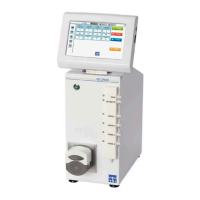22
4. Touch at the bottom right of the adjustment window to save the depth setting.
2.4 Connecting Vessels to the Multi-Channel Online Monitor
The FISP Sampling Probe and all tubing assemblies used with the Multi-Channel Online Monitor
are not compatible for vacuum autoclave cycles. Do NOT use any vacuum autoclave cycles when
autoclaving these items. Vacuum cycles include pre-vacuum and post-autoclave vacuum drying
cycles.
2.4.1 Sample Probe Installation
FISP probes allow direct transfer of the vessel contents and provide a sterile barrier for the vessel. The sterile barrier is
obtained through the use of a sterilized 0.2 um ceramic membrane mounted onto the FISP housing (Figure 1-6 & Figure
1-7). FISP sampling probes are available in two models, which are the D-Series and the F-Series sampling probes.
2.4.1.1 Sample Probe Assembly
Refer to the FISP Sampling Probe User Guide for probe assembly.
Wear latex gloves when assembling the probe. Refer to the FISP Sampling Probe User Guide for
assembly, installation, operation and maintenance of the probe.
2.4.1.2
Installing the Sample Probe
1. Insert the assembled FISP sample probe into the bioreactor. The beveled washer and O-ring form a seal between the
probe and vessel (Figure 2-11).
2. Tighten the PG 13.5 nut and remove the black plug from the sample probe.
3. Ensure the FISP probe Luer connector is tightly secured to the FISP probe.

